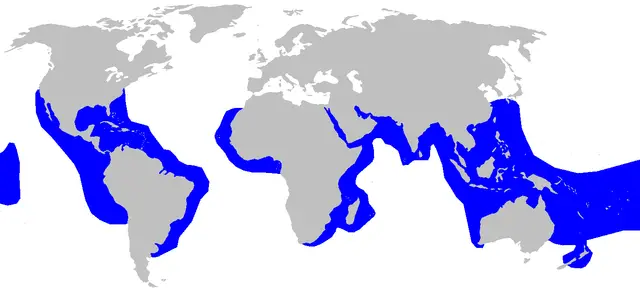The Tiger shark is a dangerous shark that is well known for its hunger for food and habitual scavenging. It also stands second among the man-eater sharks. We have gathered a complete set of Tiger Shark Facts For Kids that will provide you with all the Tiger Shark Information that you want to know. You are going to learn about its taxonomy, appearance, size, weight, speed, mouth, teeth, population, lifespan, diet, habitat, range, predators, reproduction, lifecycle, adaptations, baby tiger sharks, conservation, and many other interesting tiger shark facts for kids.
Tiger Shark Facts For Kids
1. What Is A Tiger Shark
- Tiger Shark is a requiem shark species that belongs to the family Carcharhinidae.
- It is the only existing member of the genus Galeocerdo.
- Tiger Shark is an inhabitant of temperate and tropical waters all around the world.
- The younger individuals have dark stripes on the body like the patterns of a tiger, that is why it is called a Tiger Shark.

2. Tiger Shark Scientific Name
- The scientific name of Tiger Shark is “Galeocerdo cuvier”.
3. Tiger Shark Taxonomy
- The following is the taxonomy or classification of Tiger Shark:
- Kingdom Animalia
- Phylum Chordata
- Subphylum Vertebrata
- Class Chondrichthyes
- Order Carcharhiniformes
- Family Carcharhinidae
- Genus Galeocerdo
- Species Galeocerdo cuvier
4. What Does A Tiger Shark Look Like – Tiger Shark Physical Description
- Tiger Shark is easily distinguishable among other requiem sharks due to several distinctive characteristics.
- They have a body length of 3.25 to 4.25 meters.
- They have a slender body with long dorsal fins and a long caudal fin.
- Its head has a flat and broad structure with a shorter snout and wide mouth.
- They have extremely sharp and unique teeth.
- The skin of juveniles has stripes like a tiger’s pattern.
- Their skin color ranges from blue to greenish-grey with a light yellow or white underbelly.
- They also have sexual dimorphism and the female individuals have a distinctly larger body size than males.

5. How Big Is A Tiger Shark – Tiger Shark Size
- The common body length of a Tiger Shark is 10 feet 8 inches to 13 feet 11 inches (3.25 to 4.25 meters).
- Their body weight ranges from 849 to 1,400 pounds (385 to 635 kg).
- Due to sexual dimorphism, females have a greater body size than male individuals.
6. Tiger Shark Average Size
- A Tiger Shark reaches the average body weight of 385 to 635 kg (849 to 1,400 pounds) and the average body length of 3.25 to 4.25 meters (10 feet 8 inches to 13 feet 11 inches).
7. How Long Is A Tiger Shark – Tiger Shark Length
- The common body length of a Tiger Shark ranges from 3.25 to 4.25 meters (10 feet 8 inches to 13 feet 11 inches).
8. How Big Can A Tiger Shark Get
- Commonly, Tiger Sharks have a bodyweight of 385 to 635 kg (849 to 1,400 pounds) and a body length of 3.25 to 4.25 meters (10 feet 8 inches to 13 feet 11 inches).
- The recorded female individuals of exceptional size had a body length of 5 meters (16 feet 5 inches) while males of 13 feet 1 inch (4 meters).
9. Biggest Tiger Shark – Largest Tiger Shark Ever Caught
- The recorded biggest Tiger Shark was a pregnant female that was caught off the coast of Australia and had a body length of 18 feet 1 inch (5.5 meters) while weighing about 3,360 pounds (1,524 kg).
10. How Much Does A Tiger Shark Weigh – Tiger Shark Weight
- The weight of a Tiger Shark commonly ranges from 849 to 1,400 pounds (385 to 635 kg).
- The verified weight of the biggest female Tiger Shark was 2,000 pounds (900 kg).
11. How Fast Can A Tiger Shark Swim – Tiger Shark Speed
- The average swimming speed of a Tiger Shark is 3.85 km/h (2.4 mph).
- They can swim at the fastest speed of 32 km/h (19.8 mph) but only for short bursts particularly when they are approaching prey.
12. Tiger Shark Mouth
- Unlike other sharks in the Carcharhinidae family, Tiger Sharks have a bigger mouth.
- Their jaw has a square-type structure rather than around.
- Their mouth has unique and sharp teeth arranged in two rows in the upper and lower jaws.
- All the teeth are of identical shape with extremely sharp serrations and distinctive pointing tips emerging from the sides (like the tips of a saw).
- Despite cuts, the teeth of a Tiger Shark also work as a saw as it has a distinctive saw-like region.
- The teeth also have a distinct component that protects the large saw region from the huge biting pressure (the biting pressure in Tiger Sharks is approximately 6,000 pounds square centimeters.
13. How Many Teeth Does A Tiger Shark Have
- Tiger Sharks have 24 teeth in both the upper and lower jaw.
- The total number of teeth is 48.
- Like other sharks, the teeth of Tiger Sharks are also continuously shed and replaced by new teeth throughout its life.
14. Tiger Shark Population
- The exact population of Tiger Sharks is known, however, it is continuously declining.
- The International Union for Conservation of Nature (IUCN) listed Tiger Shark in the Near Threatened (NT) species.
15. Tiger Shark Lifespan
- The exact lifespan of Tiger Sharks is unknown, however, they live for more than 12 years.
16. Tiger Shark Food – Tiger Shark Diet
- Being an apex predator (top predator or alpha predator) a Tiger Shark has a wide range of diet and eat almost everything it found.
- The diet of adult individuals includes fishes, birds, turtles, squids, sea snakes, dolphins, and other marine mammals like dugongs (Dugong dugon), sea lions, and seals.
- They are also found of eating inedible human-made materials that do not digest and remain in their stomachs. That is why a Tiger Shark is sometimes referred to as a “garbage eater” and “dustbin of the ocean”.
- They also consume other sharks like rays and sandbar sharks and even occasionally other Tiger Sharks.
- They are also documented of attacking and eating injured or sick whales, as in 2006 they killed a sick humpback whale (Megaptera novaeangliae) near Hawaii.
- They are also scavengers and are fond of eating the dead body of whales.
- Young Tiger Sharks mostly eat small fishes and various types of small mollusks, and jellyfishes.
- When they become sexually mature or attain a body length of over 2 meters, then their diet change to large animals.
17. Tiger Shark Eating Facts
- A Tiger Shark is a nocturnal predator and usually swims near the land at night to hunt.
- They mostly hunt and eat lonely.
- Their sharp and unique dental system allows them to easily cut and slice flesh, bones, and even hard shells of the turtles.
18. Tiger Shark Prey
- A wide range of animals is the prey of Tiger Sharks.
- It includes; numerous fish species, seabirds, crustaceans, and sea snakes.
- Marine mammals like common dolphins (Delphinus), bottlenose dolphins (Tursiops), spotted dolphins (Stenella), sea lions, seals, and dungeons (Dugong dugon) are also the prey of the Tiger Sharks.
- Large sea turtles including the green sea turtle (Chelonia mydas), leatherback (Dermochelys coriacea), and loggerhead (Caretta caretta) are sophisticated prey for Tiger Sharks.
- They also hunt rays, other shark species like fully mature sandbar sharks (Carcharhinus plumbeus), and even other Tiger Sharks.
- Sick and injured whales also sometimes become the prey of the Tiger Sharks.
- Their wider mouth, heavily calcified, and tough jaws along extremely strong and sharp teeth make them capable of hunting such large-sized animals.
19. Tiger Shark Habitat
- Tiger Sharks are the inhabitants of the tropical and subtropical temperate waters all over the world.
- They do not have a fixed habitat and are generally nomadic.
- They are guided by the temperature of the water and in the cold months of the year, they are found in the waters near the equator.
- They are found in both the deep waters of oceans as well as in the shallow waters of the coasts.
- They like the turbid waters of the coasts as various species of their prey often gather there.
20. Tiger Shark Habitat Map

21. Tiger Shark In Captivity
- Several aquaria kept the Tiger Sharks in captivity, some of which survived, some were released, while the others died.
- In August 2009, the Adventure Aquarium in Camden Waterfront, New Jersey kept a male Tiger Shark that survived only for two years and died in July 2011.
- In February 2009, a female Tiger Shark pup was kept in the Pacific Aquarium in California. It was removed from her mother’s uterus after hunting by the fishermen. It outgrew in the aquarium and the available exhibit became shorter for it. So it spent only 7 months in captivity and was released in September 2009.
- Three Tiger Sharks were kept in two different exhibits in the Atlantis Paradise Island Resort, the Bahamas for 2 years and 6 months.
- In 1995, a female Tiger Shark was brought to Henry Doorly Zoo, Omaha (US) where it spent 1.5 years and was then released.
- In Osaka Aquarium, Japan, a male Tiger Shark arrived on September 25, 2008.
- In the Sea World Marine Park in Gold Coast, Australia, there are two Tiger Sharks one male and one female.
- Acuario de Veracruz (Veracruz Aquarium) in Mexico kept a Tiger Shark specimen for more than seven years that was then released and monitored through satellite.
22. Tiger Shark Range
- Tiger Sharks are common and have a worldwide range.
- They are found off the coasts of North America, in the Gulf of Mexico, and some regions of South America.
- They are also found on the beaches of Carolina, Florida, and Georgia.
- Tiger Sharks are found abundantly in the Caribbean sea.
- They have a far wide range in the western Pacific Ocean in the north from Japan to the south in New Zealand.
23. Tiger Shark Adaptations
- Tiger Sharks have several adaptations that help them to survive in the ocean.
- Their special and unique dental system, the structure of the jaws and mouth helps them to easily grab and slice big-sized prey.
- A Tiger Shark has a nictitating membrane in its eyes, which is a transparent membrane that acts as a third eyelid. They also have tapetum lucidum (a tissue layer behind the retina that reflects the visible light) in their eyes that give second chance to the light-sensing cells to capture the rays of visible light. That is why Tiger Sharks have an excellent vision even in low-light conditions.
24. Tiger Shark Location
- The tropical and subtropical waters all over the world are the main locations of the Tiger Sharks.
- It is found in deep waters but also sometimes moves into the channels to approach the prey in shallow waters.
- Other locations of the Tiger Sharks include Australia, Africa, China, India, and Indonesia.
Tiger Shark Florida
- Tiger Shark is one of the shark species commonly found in Florida.
- Open waters of the ocean, river mouths, and shallow bays are their habitat in Florida.
Tiger Shark Hawaii
- As Tiger Sharks have a wide habitat range, they are also abundantly found in Hawaii.
- In August 2016, a research team from the Hawaii Institute of Marine Biology started a project to obtain important information about the habitat selection and behavior of the Tiger Sharks.
- The project is still in progress and the team is also utilizing new technologies.
- They attached a new type of satellite tag to the dorsal fin of the Tiger Shark that records significant oceanographic data, including the oxygen profile and temperature of the ocean, and the surface temperature of the sea along with other information.
Tiger Shark Bahamas
- Tiger Sharks are widely found in the Bahamas.
- The Atlantis Paradise Island Resort in the Bahamas also kept three Tiger Sharks in captivity for more than two years.
- The Bahamas is also one of the best destinations you can see and dive with Tiger Sharks.
Tiger Shark Maldives
- Tiger Sharks greatly occur in the Maldives.
- Fuvahmulah in the Maldives is considered as the Tiger Sharks’ hidden heaven and is one of the world’s best places to see and dive with Tiger Sharks.
Tiger Shark Australia
- Australia is one of the habitats of Tiger Sharks where they are greatly found.
- The Sea World Marine Park in Gold Coast, Australia is keeping Tiger Sharks in captivity since the early 80s.
- Currently, there are about two Tiger Sharks in the Shark Bay of Sea World (Gold Coast).
25. Tiger Shark Life Cycle Facts
- Tiger Shark is the only Ovoviviparous species in the whole Carcharhinidae family of requiem sharks.
- Male individuals become sexually mature when they attain a body length of 7.5 to 9.5 feet (2.3 to 2.9 meters) and females of 8.2 to 11.5 feet (2.5 to 3.5 meters).
- In Tiger Sharks, fertilization is internal.
- The partially developed embryo hatch internally and further resides inside the mother’s body until full development before birth.
- Tiger Sharks have a gestation period from 14 to 16 months.
- A female Tiger Shark reproduces once after every 3 years and gives birth to 10 to 80 pups at a time.
- The newborn pups have 20 to 30 inches (51 to 76 cm) body length.
- The exact lifespan of Tiger Sharks is unknown, however, they live for more than 12 years.
26. Tiger Shark Embryos
- The embryos (partially developed offsprings) of Tiger Sharks hatch internally before full development.
- The further development of the embryo occurs internally inside the mother’s body.
27. Tiger Shark Eggs
- Tiger Shark is an Ovoviviparous species.
- Inside the female’s body, eggs develop, however, they do not lay eggs, but rather the eggs hatch inside the mother’s body.
- From the eggs, partially developed embryo hatches and remains inside until complete development.
28. Baby Tiger Shark
- Baby Tiger Sharks are called pups.
- They have 20 to 30 inches (51 to 76 cm) body length at the time of birth and have a thin body.
- Baby Tiger Sharks have a long tail due to which they can not swim fastly.
- They have strip patterns on their bodies that become light when they develop.
- The patterns of stripes help them to camouflage the predators as due to the strips they look like an underwater shadow.
- Baby Tiger Sharks eat small aquatic animals like small fishes and various types of crustaceans.
- At the age of about 5 years, they become sexually mature.
- At that time, the females have a body length of about 8.2 to 11.5 feet (2.5 to 3.5 meters) while the male individuals have about 7.5 to 9.5 feet (2.3 to 2.9 meters).
29. How Many Babies Can A Tiger Shark Have
- Tiger Sharks give birth to pups in a litter.
- The range of the litters a female gives birth at a time is from 10 to 80.
- The average number of pups born at once is about 40.
30. Tiger Shark Predators
- Tiger Shark is itself an apex predator and hunts a wide variety of aquatic animals.
- Human beings are the main predators of the Tiger Sharks and hunt them for fins, meat, and liver.
- Shark fins are extremely expensive seafood all around the world, while its liver has a higher content of vitamin A and is utilized for vitamin oils production.
- They are also captured during big-game fishing, as well as for their distinct striped skin.
- Besides humans, killer whales are the only natural predator of Tiger Sharks.
31. Tiger Shark Conservation facts
- Due to excessive fishing and finning, the IUCN (International Union for Conservation of Nature) considers Tiger Shark as a Near Threatened (NT) species.
- In 2018, Tiger Sharks were classified as a “Migrant” along with the qualified “Secure Overseas” by the New Zealand Department of Conservation under the New Zealand Threat Classification System.
- The environmental organization Greenpeace International also added Tiger Shark to their seafood red list in 2010.
32. Extinct Tiger Shark
- Tiger Sharks are not extinct.
- They are Near Threatened, however, do not have a higher risk of extinction.
33. Tiger Shark Vs Bull Shark
| Tiger Shark | Bull Shark | |
| Shark type | Requiem Shark | Requiem Shark |
| Maximum size | 16 feet 5 inch | 13 feet |
| Maximum weight | 2,000 pounds (900 kg) | 694 pounds (315 kg) |
| Teeth | Excessively strong and sharp | Strong and sharp |
| Habitat | Warm and temperate waters of oceans all around the world | Warm and temperate waters of oceans but also survive in freshwater |
| Behavior | Aggressive | More aggressive and dangerous |
| Bite force | 16,460 Newtons | 5,914 Newtons |
| Reproduction mode | Ovoviviparous | Viviparous |
| Conservation status | Near Threatened | Near Threatened |
34. Sand Tiger Shark Vs Tiger Shark
| Tiger Shark | Sand Tiger Shark | |
| Family | Carcharhinidae | Odontaspididae |
| Maximum size | 16 feet 5 inch | 10.5 feet |
| Maximum weight | 2,000 pounds (900 kg) | 440 pounds (200 kg) |
| Teeth | Excessively strong and sharp | Sharp |
| Diet | Carnivore | Carnivore |
| Behavior | Aggressive | Non-aggressive |
| Lifespan | More than 12 years | More than 15 years |
| Habitat | Warm and temperate waters of oceans all around the world | The epipelagic and mesopelagic regions of all the world ocean except the Eastern Pacific |
| Conservation status | Near Threatened | Vulnerable |
35. Tiger Shark Vs Great White Shark
| Tiger Shark | Great Tiger Shark | |
| Shark type | Requiem Shark | Mackerel Shark |
| Maximum size | 16 feet 5 inch | 20 feet |
| Maximum weight | 2,000 pounds (900 kg) | 4,200 pounds (1,905 kg) |
| Teeth | Excessively strong, serrated, and sharp | Strong and serrated |
| Lifespan | More than 12 years | Up to 70 years |
| Diet | Carnivore | Carnivore |
| Bite force | 16,460 Newtons | 18,216 Newtons |
| Reproduction mode | Ovoviviparous | Ovoviviparous |
| Conservation status | Near Threatened | Vulnerable |
36. Tiger Shark Attack – Tiger Shark Dangerous Facts
- Tiger Shark is one of the most dangerous species of Sharks.
- It is one of the three shark species that are responsible for fatal attacks on humans, the other two species are the great white shark (Carcharodon carcharias) and bull shark (Carcharhinus leucas).
- They often swim near shallow canals, reefs, and harbors where they encounter humans.
- Near the coasts of Hawaii, large terrestrial mammals like goats (Capra aegagrus hircus), dogs (Canis lupus familiaris), sheep (Ovis aries), horses (Equus ferus caballus), brown rats (Rattus norvegicus), and cats (Felis catus) are commonly found in stomachs of Tiger Sharks.
37. Tiger Shark Attacks Human
- Among all the recorded deadly shark attacks on humans, Tiger Shark is on the second number just behind the great white shark (Carcharodon carcharias).
- Despite its large share in the human-attacking incidents by sharks, they rarely bite humans when not provoked.
- In the reported 111 attacks of Tiger Sharks on humans, 31 were fatal and caused the death of the victims.
38. Tiger Shark Drawing





